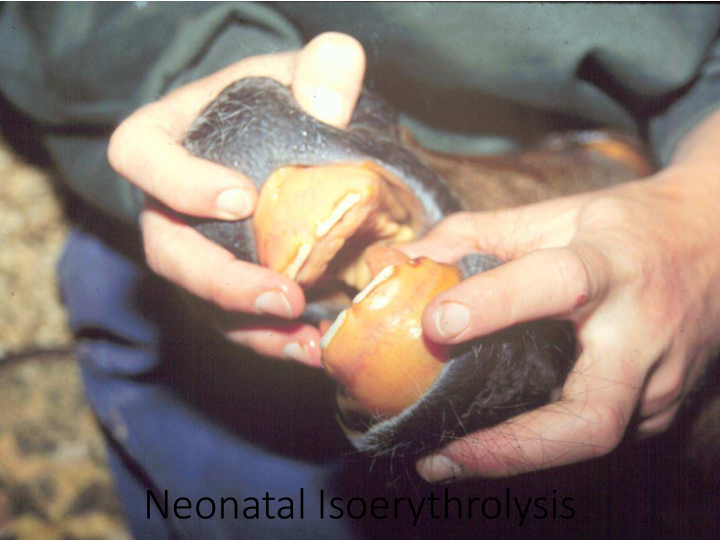



Neonatal Isoerythrolysis
Neonatal Isoerythrolysis Pathogenesis • Immune mediated hemolytic anemia • Mediated by maternal anti-RBC antibodies • Colostrum
Neonatal Isoerythrolysis Pathogenesis • Foal inherits specific RBC Ag from the sire • Dam does not have these Ag • Dam previously sensitized • Placental bleeding - previous pregnancies • Previous whole blood transfusion • Equine biologics • Plasma contaminated with RBC Ag
Neonatal Isoerythrolysis Pathogenesis • Current pregnancy mare re-exposed • Mounts antibody response • Concentrates antibodies in colostrum • Foal absorb the colostral Abs • Hemolytic Anemia
Neonatal Isoerythrolysis Pathogenesis • 32 blood group antigens in horses • Aa and Qa 90% of the reactions • R and S groups most of the rest • Based on gene frequencies • TB, QH, Saddlebred, - Qa & Aa • Standardbred, Morgan - Aa (not Qa) • Arabian - Qa
Neonatal Isoerythrolysis Clinical signs • Onset • 8-120 hours old • Depends on amount of antibody absorbed • Titer in colostrum • Amount ingested • More antibody absorbed • More rapid the onset • More severe the disease
Neonatal Isoerythrolysis Peracute disease • Severe, acute anemia (massive hemolysis) • No hypoxemia • Tissue hypoxia • Metabolic acidosis • MODS
Neonatal Isoerythrolysis Peracute disease • Normal at birth • Sudden onset • Weakness • Tachycardia • Tachypnea • Collapse
Neonatal Isoerythrolysis Peracute disease • Neurologic derangement • Fever or hypothermia • Cardiovascular collapse • Shock • Death - often before icteric
Neonatal Isoerythrolysis Acute disease • Normal at birth • Progressive weakness • Icterus (may become extreme) • Exercise intolerance • Tachycardia • Tachypnea • Fever (secondary to hemolysis) • Hemoglobinuria
Neonatal Isoerythrolysis Subacute disease • Normal at birth • Only sign may be icterus • Can be febrile • Can have brief hemoglobinuria • Mild tachycardia/tachypnea • May go undetected
Neonatal Isoerythrolysis Lab data • Anemia - mild to severe (as low as 4-8%) • Plasma very icteric • Plasma may be pink • Hyperbilirubinemia - primarily unconjugated
Neonatal Isoerythrolysis Test before foal nurses • Hemolytic test • Dam's serum • + foal's RBC • + complement • Not easily done on farm • Jaundice Foal Agglutination Test • Does not test hemolysis • But good correlation with it • Easy procedure • Whole blood cross match
Neonatal Isoerythrolysis Treatment • If signs during first 24 hours • for first 24-36 hrs • Strip colostrum from mare • Discard - do not feed to other foals • Don’t allow nursing • Separate foal from mare • Muzzle foal and cover udder • Find foal alternate source of colostrum
Neonatal Isoerythrolysis Treatment • Most important - minimize stress • Difficult since otherwise normal • Need to be confined - blood samples • Monitor PCV (serial samples needed) • Watch for hemolytic episodes • Fever • Hemoglobinuria • Tachypnea, Tachycardia • Muscle fasciculations
Neonatal Isoerythrolysis Treatment • Particularly susceptible to infections • Insure adequate IgG • Antimicrobial therapy in severe cases • Maintain adequate nutrition, hydration • Monitor renal function
Neonatal Isoerythrolysis Blood transfusion • PCV in low teens • PCV is dropping rapidly • When signs of severe anemia are present • Even if PCV is not extremely low • Monitor lactate • Monitor HR
Neonatal Isoerythrolysis Blood transfusion • Whole or packed cells • Mare's washed RBC • Aa and Qa Ag negative donor • Cross-matched blood
Neonatal Isoerythrolysis Blood transfusion • Cross-match • Major side compatibility • Minor will not be compatible • Foal's RBC's already coated with Ab • Autoagglutinate or autohemolize • Transfused RBC (if well matched) • Nearly normal life span • Unlike older horses
Neonatal Isoerythrolysis Prevention - Identify mares at risk • If mare has had an NI foal • Can blood type mare and stallion • Breed based on blood groups • Predict likelihood of problem • Test mare's sera • In late pregnancy • Run the JFA test before foal nurses
Neonatal Isoerythrolysis Prevention - Take measures at birth • Cover udder in late pregnancy • Attend birth • Before foal nurses & for first 24-36 hr • Separate foal/mare • Muzzle foal and cover udder • Strip colostrum from mare • Alternate source colostrum/nutrition
Neonatal Isoerythrolysis Sequela • Kernicterus • Iron Toxicity • Liver failure
Recommend
More recommend